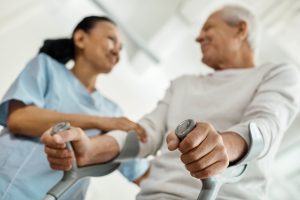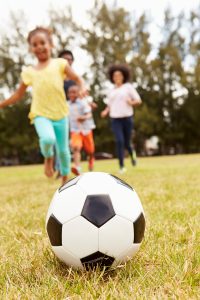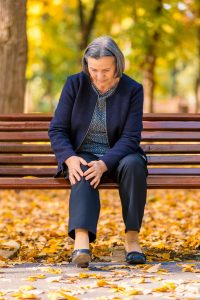Use these four case studies to test your knowledge of OA in the context of real-world patient scenarios, which span the content covered in the other eight modules.
DOWNLOAD PDFCase Study #1
 You are seeing Betty, a 65-year-old woman, for the first time. Her reason for scheduling this appointment was to ask for advice regarding ibuprofen or glucosamine with chondroitin to help with “arthritis pain” in both her hands. From looking at her chart, you see that she has a BMI of 31 kg/m2, has hypertension and type 2 diabetes mellitus, and is currently employed as a seamstress.
You are seeing Betty, a 65-year-old woman, for the first time. Her reason for scheduling this appointment was to ask for advice regarding ibuprofen or glucosamine with chondroitin to help with “arthritis pain” in both her hands. From looking at her chart, you see that she has a BMI of 31 kg/m2, has hypertension and type 2 diabetes mellitus, and is currently employed as a seamstress.
Q1. What are Betty’s risk factors for OA?
A. Gender
B. Age
C. Weight
D. Occupation
E. All of the above
Rationale (E) Female sex is associated with an increased risk of OA, especially OA of the hand, foot, and knee. Advancing age is by far the most well-known risk factor for OA. Betty’s weight is also a risk factor, even though her OA symptoms are currently only present in her hands; there is research showing that obesity can increase the risk of hand OA. Certain occupations that involve repetitive motion of a joint, like sewing, can worsen OA symptoms.
On examination, both of Betty’s hands appear normal (e.g., no deformities and no visible signs of inflammation); however, Betty reports stiffness and pain (lasting for ~15-20 minutes) when she first wakes up and after resting for prolonged periods. She has not missed any days from work, but admits the pain is significantly worse compared to a year ago. When asked, Betty states she is looking for pain relief and fears the arthritis “will spread” to her other joints.
Q2. What points of information should be shared with Betty?
A. Education about OA
B. Weight loss counseling
C. Sample hand exercises
D. Offer a referral to Occupational Therapy
E. All of the above
Rationale (E): Providing Betty with education about OA and explaining that it does not “spread” is a good place to start. It is important, however, to identify Betty’s risk factors and explain the importance of self-management strategies. While weight loss may not appear relevant to hand OA and could be daunting for a patient who is obese, education on the importance of weight loss, even a modest 5-10 pounds, can significantly improve mobility and function as well as reduce pain and may even help prevent OA in other joints such as her knees. You can encourage Betty to engage in healthy eating habits as well as hand exercises. One simple suggestion to increase mobility is that while Betty is watching TV, for example, she opens and closes her hands 5-10 times when a commercial is played. You can offer to submit a referral to an occupational therapist who can evaluate her for splinting, suggest additional exercises for hands, and recommend joint protection strategies in addition to assistive devices. If you feel that Betty can handle additional information, consider giving her a handout that describes resources and programs available for adults with OA to support physical activity, weight loss, managing pain, self-care, social support, and medical care.
Q3. What drug therapy poses the least risk for Betty?
A. Topical capsaicin
B. Oral NSAID
C. Acetaminophen
D. Glucosamine with chondroitin
Rationale (C): Given Betty’s age as well as her history of hypertension and diabetes, an NSAID should be avoided as first-line therapy. Neither glucosamine nor chondroitin will treat her acute pain and the benefit of these agents in OA is unsubstantiated. Alternatively, APAP (< 3 grams per day) may be a safe and effective treatment option for Betty. While taking APAP, Betty should be counseled to avoid other APAP-containing products (e.g., cough and cold remedies or any product claiming to be “aspirin free”).
Comorbidities & Co-Occurring Symptoms, OA Signs & Symptoms, OA Pathogenesis & Risk Factors, Clinical Management of OA, Engaging Patients in OA Management Strategies
Relevant patient and provider resources
OAAA’s What is Osteoarthritis handout, Dealing with Osteoarthritis handout, Learn to Live a Full Life with OA handout, Hand exercises (Harvard Health Publishing & Creaky Joints), Interpreting the 2019 ACR Guidelines, Topical & Oral Analgesics for OA Pain Management
Case Study #2
John and his wife come in for a primary care visit following his hospital discharge. John is a 70-year-old man who is slightly overweight and has dyslipidemia, hypertension, and knee OA. He recently suffered a right cerebral vascular accident (CVA) due to atrial fibrillation that resulted in mild left hemiparesis. Prior to his stroke, he was prescribed a statin, ACE-inhibitor, diuretic, and calcium channel blocker.

In addition, John has new prescriptions for novel oral anticoagulant (NOAC) for secondary stroke prevention and an NSAID for knee pain, which was exacerbated during his post-CVA physical therapy sessions in the hospital. John has been mostly sedentary since he retired 5 years ago. In fact, other than physical rehabilitation in the hospital, he has not been physically active in years. He will begin outpatient physical therapy tomorrow for post-CVA rehabilitation.
Q1. What should be your primary concern?
A. Assessing whether John is able to take care of himself at home
B. Addressing a drug interaction
C. Submitting a referral for occupational therapy
D. Recommending community-based physical activity programs
Rationale (B): Given the significance of the drug interaction between the NSAID and NOAC, this should be your primary concern. While an oral NSAID may provide pain relief for his knee OA, John’s age, co-morbidities, and concomitant drug therapy makes an oral NSAID relatively contraindicated. You learn that a trial of acetaminophen at a dose of 3 grams per day was not helpful in relieving Johns’ increased knee pain, so you could consider a topical NSAID. While these drugs carry the same black box warnings as oral NSAIDs, research has shown that the drug interactions with the NOAC, ACE-inhibitor, and diuretic are reduced; thereby, reducing the risk of bleeding and acute renal failure.
Q2. What non-pharmacologic treatment modalities should be recommended?
A. Weight loss
B. Reduce periods of physical inactivity
C. Community-based physical activity programs
D. All of the above
Rationale (D): It would be important to encourage John to lose even a minimal amount of weight through improved diet and increased physical activity. Reducing his periods of inactivity will also help with his knee OA pain, as sustained periods of rest can worsen OA symptoms; therefore, promoting simple activity (e.g., every 20-30 minutes) may reduce OA pain and stiffness. You can also encourage him to discuss specific exercises with his outpatient physical therapist that will target the OA in his knee; the PT can give him exercises to do on his own at home. There are also many community programs designed specifically for patients with OA that John could transition to when his PT sessions are complete.
Case wrap up and recommendations:
Now that John is home, you will likely need to help in the coordination of care by advising continued therapy with physical therapy or cardiac rehabilitation and helping him find ways of staying physically active after therapy concludes. You can also provide ongoing coaching on simple ways to increase activity around the home and to manage his weight through his diet. It might be helpful to refer him to a registered dietitian. Because of the impact of his stroke, John is at risk for falls; therefore, promotion of safety is paramount. You can encourage John that his participation in physical activity will not only help improve his OA symptoms and hypertension but will also help him strengthen his lower body to prevent falls which could cause further limitations and disability. Periodic reassessment should also take place to evaluate his current non-drug and drug therapy regimens.
Comorbidities & Co-Occurring Symptoms, OA Pathogenesis & Risk Factors, Clinical Management of OA, Engaging Patients in OA Management Strategies
Relevant patient and provider resources
OAAA’s What is Osteoarthritis handout, Dealing with Osteoarthritis handout, Learn to Live a Full Life with OA handout, CDC’s STEADI initiative (Stopping Elderly Accidents, Deaths, & Injuries), Engaging Patients in OA Management Strategies PPT, Topical & Oral Analgesics for OA Pain Management video, Exercise Rx for Arthritis (for HCPs) and Getting Started with Physical Activity for Arthritis (for patients)
Case Study #3
 Emma is a 35-year-old woman who injured the ACL and meniscus in her right knee playing NCAA collegiate soccer at age 20. Her ACL was surgically reconstructed, and she returned to play after completing a full physical rehabilitation program. During her annual physical, she comments that her right knee feels achy some mornings when she wakes up. She also notes that while kicking the soccer ball with her children over the last couple of months, she has felt twinges of pain and a feeling of weakness in her right knee. Emma is 5’11” and 215 pounds (BMI 30 kg/m2). On her pre-visit worksheet, Emma reported that she engages in moderate exercise about once per week for 30 minutes but is otherwise fairly sedentary. She also reported eating fast food for lunch 5 days a week.
Emma is a 35-year-old woman who injured the ACL and meniscus in her right knee playing NCAA collegiate soccer at age 20. Her ACL was surgically reconstructed, and she returned to play after completing a full physical rehabilitation program. During her annual physical, she comments that her right knee feels achy some mornings when she wakes up. She also notes that while kicking the soccer ball with her children over the last couple of months, she has felt twinges of pain and a feeling of weakness in her right knee. Emma is 5’11” and 215 pounds (BMI 30 kg/m2). On her pre-visit worksheet, Emma reported that she engages in moderate exercise about once per week for 30 minutes but is otherwise fairly sedentary. She also reported eating fast food for lunch 5 days a week.
Q1. What are Emma’s risk factors for developing OA?
A. Having had a knee injury
B. Being female
C. Being overweight
D. All of the above
Rationale (D): Emma has a combination of modifiable and non-modifiable risk factors for developing OA. The non-modifiable risk factors include being female and having a prior injury. Emma’s modifiable risk factor is being overweight.
Q2. What strategies would best help Emma reduce her pain and slow the progression of OA?
A. Lose weight and increase physical activity
B. Oral or topical NSAIDs
C. Intraarticular corticosteroid injection
D. Nothing; knee pain is inevitable with aging, and she should learn to live with it.
Rationale (A): In Emma’s case, losing weight is going to help reduce her OA symptoms significantly. A 10-pound weight loss can reduce the amount of knee joint loading by 40 pounds. Increasing physical activity is definitely recommended, too; it reduces pain, strengthens muscles, helps prevent the progression of OA and is an important part of a weight loss program. Emma could use acetaminophen when she has increased pain, but she should be cautioned to avoid cold or cough remedies also containing acetaminophen. Emma can also be encouraged that OA pain is not inevitable despite her age and prior sports history and that with proper management, she can return to a pain-free lifestyle.
Q3. What might it look like to use the 5 As model with Emma to discuss her weight? The 5 As model guides you to: Ask→ Assess→ Advise→ Agree→ Assist.
A. You ask Emma to increase her physical activity because you determined that she is obese based on her BMI and because she reports being mostly sedentary on the assessment form. You recommend that she perform moderate physical activity 150 minutes per week, and you set this as her SMART goal, to which she agrees. You recommend gyms in the area that she could join.
B. You ask Emma if she would like to be a healthier weight. You suggest that increased physical activity and nutrition counseling help many patients, and advise her to do both. You refer her to a physical therapist who can help her with her knee pain and develop an appropriate physical activity program. You also refer her to a registered dietitian.
C. You ask Emma if she has concerns about her weight, and she says she does and that she would like to be a healthier weight. You examine her chart again and note that she commonly eats fast foot and is mostly sedentary. You suggest increased physical activity and nutrition counseling, and ask her which of these modifications is possibly achievable for her now. Emma thinks diet change is possible, so you help her set a SMART goal to improve her diet and refer her to a registered dietitian.
D. You ask Emma if it would be alright if you discussed her weight, and she states that she would like to learn how to achieve a healthy weight. Based on information you learned from her chart and her assessment form that she completed, you tell her she needs to be more physically active and to change her diet to lose weight. You advise her to keep a food journal, and you tell her that diet change is an achievable SMART goal for her. You refer her to a registered dietitian.
Rationale (C):
Ask: Ask if Emma would be willing to talk to you about her weight. Does she have concerns about her weight? If she answers yes to these questions, then proceed.
Assess: You notice in Emma’s chart that her weight gain really escalated after the birth of her second child a couple of years ago, and from her answers on the patient information form, you see that she is getting less than 150 minutes of moderate to strenuous exercise per week. Ask Emma about other contributing factors such as diet, sleep, and depression.
Advise: You can tell that Emma knows the risks of being overweight on her cardiovascular health and her chance of developing diabetes. Tell her that she has two major risk factors for osteoarthritis (OA): excess weight and previous knee injury and that her knee pain could be from OA. Let her know that she is 2-4 times more likely to develop OA because of her previous knee injury. It could also help Emma to hear that every pound of weight she loses, would mean 4 pounds less of pressure on her knee joints. Offer Emma some options for weight loss strategies (increased physical activity, nutrition counseling, food journaling, etc) and see which she thinks is most realistic right now.Agree: If Emma is willing and ready, help her set 1-2 SMART goals (Specific, Measurable, Achievable, Realistic, Time-bound) around increasing her physical activity and/or addressing her diet or sleep habits.
Assist: If appropriate, ask Emma if she would like a referral to see a nutrition counselor. It might also be beneficial for Emma to see a Physical Therapist or Sports Medicine professional to get help developing a neuromuscular training program that includes strengthening, balance, and plyometric exercises; this will help her prevent future injury to her knees. These professionals could also fit her for a knee brace if appropriate. You can ask Emma if she needs any community resources for fitness programs. Finally, make a plan to follow-up with Emma. If your practice has a chronic care manager, schedule her to have a series of phone calls with the case manager. Offer to see her back for a follow-up appointment with you in 3-6 months.
OA Signs & Symptoms, OA Pathogenesis & Risk Factors, Clinical Management of OA, Engaging Patients in OA Management Strategies
Relevant patient and provider resources
OAAA’s What is Osteoarthritis handout, Dealing with Osteoarthritis handout, Learn to Live a Full Life with OA handout, Engaging Patients in OA Management Strategies PPT, Interpreting the 2019 ACR Guidelines, Topical & Oral Analgesics for OA Pain Management
Case Study #4
 Maria is a 66-year-old woman presenting to you for evaluation of knee pain, worse on the right. She states that she has had knee pain on the right for a few years, but it has progressively gotten worse and in the last 6 months or so she has noticed similar pain on the left. She describes an “aching” pain on the inside of the knees, occasional “grinding” and rarely some mild swelling on the right. Her right knee is stiff for 5-10 minutes most mornings and often feels stiff after prolonged sitting. Her pain is typically worse at the end of the day, or when she is more active, particularly with gardening, and improves somewhat with rest. She is able to ambulate independently and does her own shopping. She enjoys gardening but uses a stool rather than stooping. She is otherwise relatively sedentary.
Maria is a 66-year-old woman presenting to you for evaluation of knee pain, worse on the right. She states that she has had knee pain on the right for a few years, but it has progressively gotten worse and in the last 6 months or so she has noticed similar pain on the left. She describes an “aching” pain on the inside of the knees, occasional “grinding” and rarely some mild swelling on the right. Her right knee is stiff for 5-10 minutes most mornings and often feels stiff after prolonged sitting. Her pain is typically worse at the end of the day, or when she is more active, particularly with gardening, and improves somewhat with rest. She is able to ambulate independently and does her own shopping. She enjoys gardening but uses a stool rather than stooping. She is otherwise relatively sedentary.
Q1. What additional evaluation is needed to confirm the etiology of her knee pain?
A. Bilateral standing knee x-rays
B. Erythrocyte sedimentation rate
C. Serum uric acid level
D. MRI of the right knee
E. None of the above
Rationale (E): The diagnosis of OA is generally a clinical one and can be made in this patient with very typical history without additional lab or imaging studies.
Maria was diagnosed with type II diabetes 2 years ago and had a HbA1c of 8% last month. She also has hypertension, high cholesterol, chronic kidney disease, and mild COPD from remote smoking. Her medications include metformin, glyburide, pravastatin, losartan, and an inhaler. She previously took acetaminophen but stopped as it was not helping her joint pain.
Q2. What intervention is most likely to improve her knee pain with minimal risk?
A. Oral or topical NSAIDs
B. Intra-articular corticosteroid injection
C. Increased physical activity
D. Initiate scheduled acetaminophen
Rationale (C): Physical activity is the most important intervention in this case, not only because it is the most likely to lead to substantial improvements in knee pain and function (IDEA Trial1), but also because it can improve management of her other comorbid conditions. Topical NSAIDs might be a useful adjunct, but additional information about her CKD would be needed; oral NSAIDs are likely contraindicated given her age and comorbidities. Intra-articular corticosteroid could provide temporary relief for the right knee, but not the left, and has the potential to increase her blood sugar. She has already tried acetaminophen in therapeutic doses without help, and given the minimal efficacy of this agent, additional trials are unlikely to be of benefit.
On examination, Maria’s resting blood pressure is 150/95, heart rate is 90, and respiratory rate is 14. Her BMI is 32 kg/m2. She is in no acute distress, and examination of her head, neck, eyes, and ENT is unremarkable. She has an intermittent expiratory wheeze, but normal work of breathing. Her cardiovascular exam is unremarkable, as is her GI evaluation. There is no edema in her extremities. Her musculoskeletal examination demonstrates scattered non-painful Heberden’s nodes, mild thumb base squaring, but otherwise normal hands, wrists, elbows, and shoulders. Hip range of motion is preserved, there is no sacroiliac or trochanteric tenderness. She endorses tenderness to palpation of the medial joint lines of both knees, worse on the right. There is a trace effusion of the right knee, none on the left. She has full ROM of both knees but endorses some stiffness; crepitus is noted on the right. The ankles and feet are unremarkable. She does not have diffuse muscular tenderness.
Q3. For which of her conditions would increased physical activity be beneficial?
A. Symptomatic osteoarthritis
B. Type II diabetes
C. Chronic kidney disease
D. COPD
E. All of the above
Rationale (E): Physical activity is a mainstay of management of all of these conditions and is the most important recommendation for management of her osteoarthritis.
Case wrap up and recommendations
Increased physical activity is recommended to the patient, recognizing that while physical activity is likely to benefit many of this patient’s chronic medical comorbidities, she may experience difficulty in engaging in increased activity due to these conditions. For example, knee pain or shortness of breath may limit walking endurance when walking is recommended for improved diabetes management. It is essential to inventory the comorbid conditions that may impact a patient’s ability to follow physical activity recommendations and to tailor those recommendations accordingly. In this case, a program of aquatic therapy, supervised physiotherapy, or pulmonary rehabilitation could assist with getting started, followed by a graded land-based program, graded walking program, or group activity class (based on preferences and local resources). The key is to begin slowly with manageable recommendations (i.e., not to recommend 150 minutes per week at the first visit) and to make incremental gains up to a goal agreed upon by both the provider and the patient, recognizing that any increase in physical activity is likely to provide wide-ranging benefits. Additional medical management and adjunctive therapies can still be used, with the aim of assisting the patient to reach her physical activity goals while minimizing symptoms.
Comorbidities & Co-Occurring Symptoms, OA Signs & Symptoms, Clinical Management of OA, Engaging Patients in OA Management Strategies
Relevant patient and provider resources
OAAA’s What is Osteoarthritis handout, Dealing with Osteoarthritis handout, Learn to Live a Full Life with OA handout, Engaging Patients in OA Management Strategies PPT, Exercise Rx for Arthritis (for HCPs) and Getting Started with Physical Activity for Arthritis (for patients), Interpreting the 2019 ACR Guidelines, Topical & Oral Analgesics for OA Pain Management
REFERENCE
-
- Messier SP, Mihalko SL, Legault C, et al. Effects of intensive diet and exercise on knee joint loads, inflammation, and clinical outcomes among overweight and obese adults with knee osteoarthritis: the IDEA randomized clinical trial. JAMA. 2013;310(12):1263-1273.
